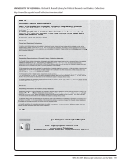SPEC Kit 307: Manuscript Collections on the Web · 91
Adequate staff to process our
collections and create finding aids.
Completely different levels of
processing for different collections,
which the finding aids reflect. Many
of the legacy finding aids lack the
contextual information (biographical,
scope notes) needed for an online
finding aid. For several years the
University we used a processing manual
that did not match national standards
and practices, our finding aids reflect
the local practices.
As we put up more finding aids,
we are seeing increased use of the
collections. Our electronic reference
service particularly reflects this use.
A challenge is to keep our reference
service at a level to meet this added
demand, from both in person and
electronic researchers.
Communicating vision about variety
of descriptive practices (e.g., MPLP)
to other professional staff and their
implementation of that vision.
Complexity and usefulness of existing
legacy finding aid.
Staff communication.
Constantly changing software,
hardware, and technology.
Lack of commercially available turnkey
systems for making finding aids
available and searchable online.
Shrinking funds and resources (at least
in higher education, yet ever-expanding
expectations from users.
Conversion of 400 legacy finding aids
required grant funding and the bulk of
staff time for 2 years.
Converting finding aids by scanning or
re-keying.
Adhering to accepted archival
standards.
Providing different venues of Web
access: online catalogue, our own Web
site, and Web union lists.
Cost. Scanning is relatively simple but
in order to make the scanned images
useful descriptive information has to
be gathered and this is time consuming
and labor intensive.
Time. Curatorial expertise is needed to
ensure that collections are appropriately
described and accessible.
A systematic way of selecting
manuscript collections to place online.
Creating, learning, and maintaining
standards of description.
The excessive amount of time and the
cost involved in migration.
Justifying #1 and #2 in light of the
relatively slight value of the work.
EAD encoding — either staff or funds
for off-site encoding of new and legacy
guides.
Systems/Web staff to deliver encoded
guides to Web.
Mechanism to allow for updates and
corrections.
Finding Aids which predate computer
age.
Adequate staff to process our
collections and create finding aids.
Completely different levels of
processing for different collections,
which the finding aids reflect. Many
of the legacy finding aids lack the
contextual information (biographical,
scope notes) needed for an online
finding aid. For several years the
University we used a processing manual
that did not match national standards
and practices, our finding aids reflect
the local practices.
As we put up more finding aids,
we are seeing increased use of the
collections. Our electronic reference
service particularly reflects this use.
A challenge is to keep our reference
service at a level to meet this added
demand, from both in person and
electronic researchers.
Communicating vision about variety
of descriptive practices (e.g., MPLP)
to other professional staff and their
implementation of that vision.
Complexity and usefulness of existing
legacy finding aid.
Staff communication.
Constantly changing software,
hardware, and technology.
Lack of commercially available turnkey
systems for making finding aids
available and searchable online.
Shrinking funds and resources (at least
in higher education, yet ever-expanding
expectations from users.
Conversion of 400 legacy finding aids
required grant funding and the bulk of
staff time for 2 years.
Converting finding aids by scanning or
re-keying.
Adhering to accepted archival
standards.
Providing different venues of Web
access: online catalogue, our own Web
site, and Web union lists.
Cost. Scanning is relatively simple but
in order to make the scanned images
useful descriptive information has to
be gathered and this is time consuming
and labor intensive.
Time. Curatorial expertise is needed to
ensure that collections are appropriately
described and accessible.
A systematic way of selecting
manuscript collections to place online.
Creating, learning, and maintaining
standards of description.
The excessive amount of time and the
cost involved in migration.
Justifying #1 and #2 in light of the
relatively slight value of the work.
EAD encoding — either staff or funds
for off-site encoding of new and legacy
guides.
Systems/Web staff to deliver encoded
guides to Web.
Mechanism to allow for updates and
corrections.
Finding Aids which predate computer
age.








































































































































































































